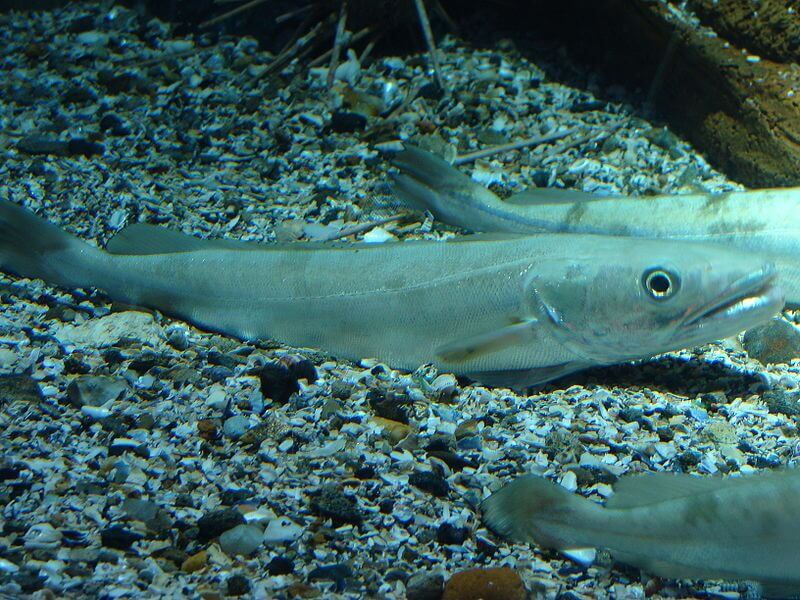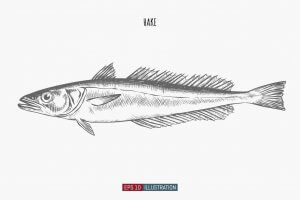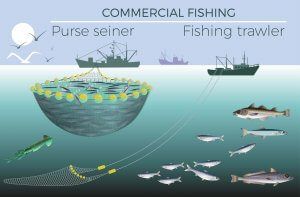Hake Migration Patterns: All You Need to Know

Hake follow two very specific migration patterns. The purpose of one is to find food, the other is for reproduction and the continuation of the species.
Hake is a type of fish that is commonly used in recipes around the world. Hake share some physical similarities with the Northern pike (Esox lucius). However, they don’t belong to the same family as the pike.
The different hake species are found in several oceans, including the Atlantic, Indian and Pacific. They are also very common in some seas, such as the Mediterranean. However, the number of hake in the Mediterranean has reduced in recent years.
Species of hake
Hake belong to the Gadiformes order of fish. This is order is characterized by a short dorsal fin and a second long fin that runs along almost the entire length of the fishes’ bodies. However, the different hake species fall under different genera. In fact, their only similarities are their physical structure and their migration patterns.
The different species of hake are:
- European hake (Merluccius merluccius)
- Southern hake (Merluccius australis)
- Silver hake (Merluccius bilinearis)
- Argentinian hake (Merluccius hubbsi)
- Panama hake (Merluccius angustimanus)
- Gayi hake (Merluccius gayi)
- Patagonian grenadier (Macruronus magellanicus)
- Patagonian toothfish (Dissostichus eleginoides), commonly found in the Indian Ocean
- White hake (Urophycis tenuis)
- Red hake (Urophycis chuss)
Silver, white and red hake are all very similar and are difficult to differentiate. In addition, all live in the Atlantic Ocean on the east coast of the United States.

Hake migration patterns
Hake live at the bottom of the sea, usually at a depth between 10 and 400 meters. However, some have been found in the Mediterranean Sea at depths of 1,000 meters.
This wide range of depths is one of the consequences of the first type of hake migration.
As we said before, hake follow two migration patterns:
- Vertical migration: This involves fish moving to the water’s surface at night and then returning to the depths during the day. Adult hake feed on small fish, such as anchovies, herring and sardines, or on squid. In turn, these squid prey on ocean plankton, which only come out at night and attract hundreds of fish. As a result, hake always swim to the water surface at night. Then, during the day, the fish move down the water column to the muddy bottom where they wait for nightfall. This way, they are protected by the darkness.
- Annual migration: When breeding season arrives, adult male and females (those around 7 and 5 years old respectively) migrate to colder waters in early spring to spawn. At this stage, the fishes’ reproductive organs have developed to the extent that they put pressure on their digestive systems. In turn, this prevents the fish from feeding. When they arrive in colder waters, both the males and females release their gametes (reproductive cells) into the water. Fertilization then takes place externally.
The economic importance of hake
Evidence currently shows that the fishing industry is overfishing several species of hake. The main methods used to fish for hake are trawling, fishing with fixed nets, and seine fishing. These methods are far from selective and some also cause serious damage to the marine environment.

The fishing economies in Europe and South America rely more on hake than they do any other demersal fish. Therefore, these countries have invested in biological and ecological research to try to understand more about this fish, of which we currently know very little.
The aim of this research is to understand the fishes’ migratory patterns, the animals they prey on and how fishing affects subpopulations of hake. New, more selective fishing techniques are also being researched with the aim of protecting the species and the environment.
In addition, several governments are trying to strengthen legislation and establish fishing programs. The aim is that these programs will prevent hake species from further deterioration. For example, some countries have prohibited the fishing of animals that are smaller than 10 inches in size. Similarly, state authorities are increasingly enforcing fishing regulations with the aim of improving the status of hake species.
All cited sources were thoroughly reviewed by our team to ensure their quality, reliability, currency, and validity. The bibliography of this article was considered reliable and of academic or scientific accuracy.
Bozzano, A., Sardà, F., & Ríos, J. (2005). Vertical distribution and feeding patterns of the juvenile European hake, Merluccius merluccius in the NW Mediterranean. Fisheries Research, 73(1-2), 29-36.
Fernandes, P., Cook, R., Florin, A.-B., Lorance, P. & Nedreaas, K. 2016. Merluccius merluccius. The IUCN Red List of Threatened Species 2016: e.T198562A84946555.
FishBase. (2009). Rainer Froese y Daniel Pauly, eds. Versión de septiembre del 2009. N.p.:
Murua, H., & Motos, L. (2006). Reproductive strategy and spawning activity of the European hake Merluccius merluccius (L.) in the Bay of Biscay. Journal of Fish Biology, 69(5), 1288-1303.
Musick, J. A. (1973). Meristic And Morphometric Comparison Of Hakes, Urophycis-Chuss And Urophycis-Tenuis (Pisces, Gadidae). Fishery Bulletin, 71(2), 479.
Sommer, M. (2005). Pesca de arrastre. Aniquilación silencionsa. REDVET. Revista Electrónica de Veterinaria, 6(4).
